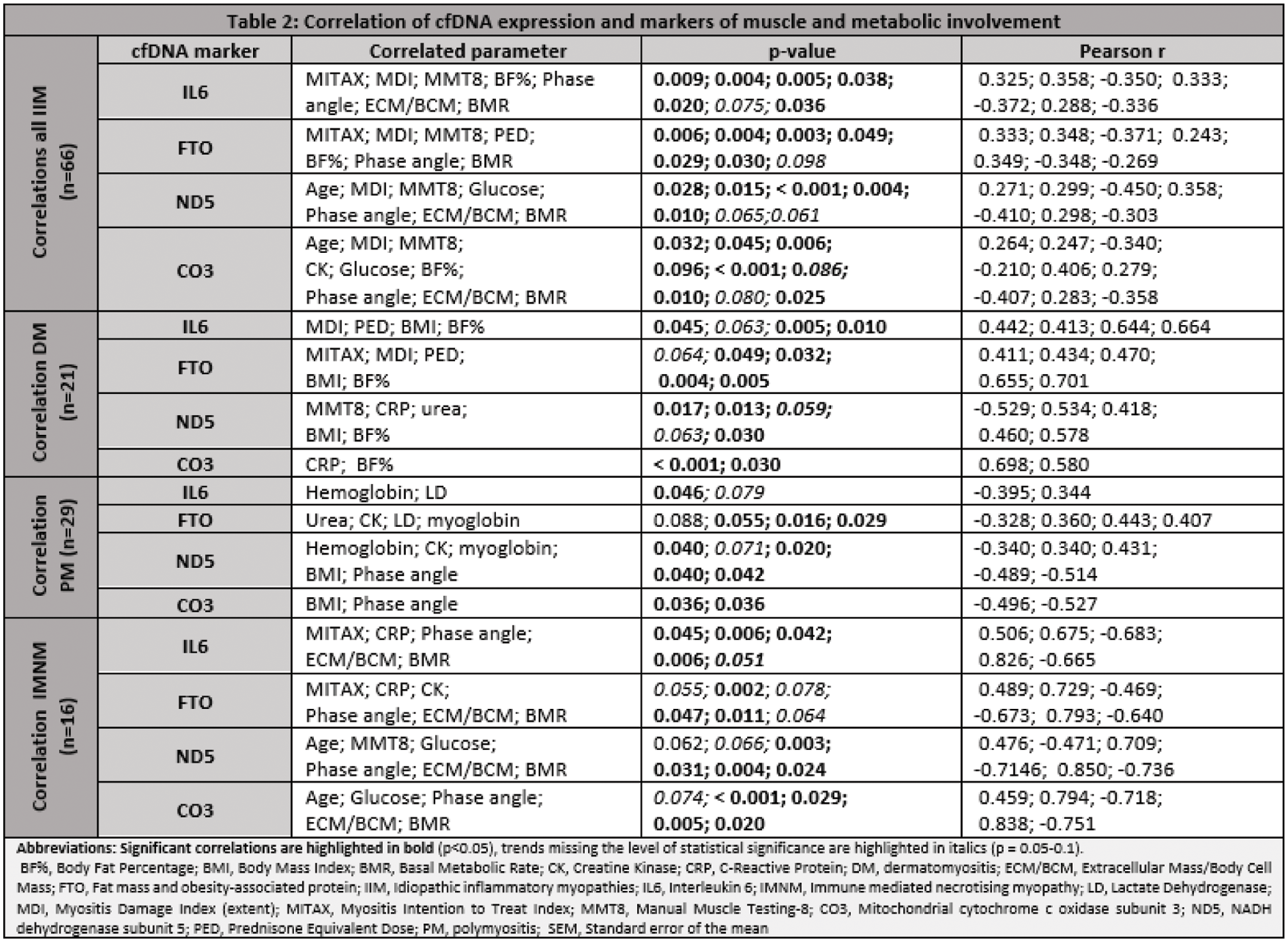

Background: Idiopathic inflammatory myopathies (IIM) are rare skeletal muscle diseases characterized by inflammatory muscle injury. Circulating cell-free DNA (cfDNA), including nuclear (cfnDNA) and mitochondrial (cfmtDNA) DNA, has been shown to increase after exercise primarily due to apoptosis or necrosis and might be a promising biomarker for inflammatory muscle injury in IIM.
Objectives: To explore the association between cfnDNA and cfmtDNA and muscle damage, muscle strength and metabolic function, and physical activity capacity.
Methods: 66 patients with IIM were included: 44 females; age mean (SD) 57.6 (13.9); disease duration 2.27 years (3.0); 21 dermatomyositis (DM)/29 polymyositis (PM), both without statin history/16 immune-mediated necrotizing myositis statin-induced (IMNM). 15 IIM (6 DM, 6 PM, 3 IMNM) had a follow-up 6 months after immunosuppressive therapy initiation to analyze the impact of treatment on cfDNA expression. In all patients, basal laboratory parameters, disease activity, damage, and muscle involvement were evaluated (Myositis Intention to Treat Index (MITAX), Myositis Damage Index (MDI), Manual Muscle Testing-8 (MMT-8)), comorbidities, and current treatment were recorded. Body composition was examined using bioelectric impedance analysis (BIA-2000-M). cfDNA was isolated from plasma using the Plasma/Serum Cell-Free Circulating DNA Purification Mini Kit (Norgen Biotek). qPCR was used to analyze 2 independent markers for cfnDNA (IL6 and CTO), and cfmtDNA (ND5 and CO3). Data are presented as mean (SD).
Results: There were no significant differences in plasma concentrations of selected cfnDNA and cfmtDNA markers among the myositis subtypes (Table 1). Elevated expression of both cfnDNA and cfmtDNA was associated with worse disease damage (MDI), decreased muscle strength (MMT8), higher body fat percentage (BF% by BIA), reduced basal metabolic rate (BMR by BIA), and decreased capacity for physical activity (higher ECM/BCM and lower phase angle by BIA). cfnDNA expression also positively correlated with disease activity (MITAX), while cfmtDNA positively correlated with age and glucose plasma levels (Table 2). The analysis of a 6-month follow-up in 15 IIM patients after immunosuppressive treatment initiation showed statistically significant reductions in disease activity, improvement of muscle strength, and decreases in levels of muscle involvement markers (CK, LD, myoglobin) (p<0.05 for all). However, the decrease in both cfnDNA and cfmtDNA expression was not significant. Lower baseline expression of cfnDNA(IL6) predicted a trend to an increase in muscle strength (MMT8) (p=0.09).
Conclusion: Expression of nuclear and mitochondrial cfDNA did not vary among the IIM subtypes, but was associated with disease activity and damage, muscle weakness, and physical function in patients with IIM. Although there was a significant improvement in muscle impairment (decrease in muscle markers, increase in muscle strength) along with the reduction in glucocorticoid doses observed in only 15 IIM patients after a 6-month initial immunosuppressive therapy, the expression of cfnDNA and cfmtDNA did not change, but there was a promising prediction of increased muscle strength by baseline expression of cfnDNA(IL6). Therefore, both cfnDNA and cfmtDNA deserve further studies to elucidate their potential role as a potential marker of muscle damage, or treatment response in IIM.


REFERENCES: NIL.
Acknowledgements: Supported by MH CR 023728, NU21-01-00146, NU21-05-00322, Ministry of Education Youth and Sports of the Czech Republic [BBMRI.cz-LM2023033], and SVV 260638.
Disclosure of Interests: None declared.
© The Authors 2025. This abstract is an open access article published in Annals of Rheumatic Diseases under the CC BY-NC-ND license (